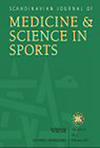将爬楼梯运动零食纳入校园对不爱运动的年轻人的可行性、感知效率和参与观点的影响:随机混合方法试点研究》。
摘要
这项为期 6 周的试点研究旨在调查大学校园爬楼梯运动零食(ES)干预的可行性、感知效果和参与度,并将其与中等强度持续训练(MICT)进行比较。健康、年轻、不爱运动的成年人(年龄:21.6 ± 2.3 岁,体重指数:22.5 ± 3.6 kg/m2)被随机分配到三组(ES 组、MICT 组和对照组 [CON])。ES 组(n = 14,6 名女性)和 MICT 组(n = 13,9 名女性)在 6 周内每周进行三次训练,而对照组(n = 15,9 名女性)则保持其习惯的生活方式。ES 组包括 3 × ~30 秒的 "全力以赴 "爬楼梯(6 层楼,共 126 级,海拔 18.9 米),每次爬楼梯后休息 > 1 小时;MICT 组包括 40 分钟的静态自行车运动,最大心率为 60%-70% 。混合线性效应模型用于探讨组内和组间差异,并使用平均差异(MD)、95% 置信区间(CI)和 Cohen's d效应大小确定变化幅度。14 名参与者还完成了干预后的半结构化访谈。从基线到后评估,ES 和 MICT 的保留率分别为 93%(ES,14/15)、93%(MICT,13/14)和 100%(CON,15/15),依从性(参与者对 ES 课程的出席率)分别为 97%(733/756 次)和 93%(217/234 次)。ES 和 MICT 在未来意向(4.8 ± 1.4 和 5.0 ± 0.9)、乐趣(PACES,89.0 ± 16.4 和 94.5 ± 11.9)和满意度方面没有发现明显差异。在生活质量和感知压力方面,发现了明显的组别 × 时间交互作用。与基线相比,ES 和 MICT 显著提高了 8%(MD = 5.5 [95% CI = 0.3, 10.7],Cohen's d = 0.64)和 6%(MD = 4.6 [95% CI = 0.9, 8.2],Cohen's d = 0.88)的生活质量,而 CON 显著降低了生活质量(MD = -7.9 [95% CI = -14.4, -1.6], Cohen's d = 0.56)。ES 显著降低了 7% 的感知压力(MD = -4.6 [95% CI = -8.9, -0.3],Cohen's d = 0.58),而 MICT(MD = 2.0 [95% CI = -0.1, 4.1],Cohen's d = 0.28)和 CON(MD = -2.4 [95% CI = -6.1, 1.3],Cohen's d = 0.22)则无显著影响。大多数参与者(12/14)普遍对参与 ES 持积极态度,并认为 ES 比预期的更容易,同时强调了促进因素、障碍和未来建议。以爬楼梯为基础的 ES 可以融入校园环境,似乎是可行的,在未来意向、乐趣和满意度方面与 MICT 相似。ES 和 MICT 都能对生活质量产生积极影响,与 MICT 或 CON 相比,ES 在减轻压力方面表现出更大的优势。访谈为促进大学生坚持 ES 提供了积极的见解。This 6-week pilot study aimed to investigate the feasibility, perceived efficacy, and participation perspectives of a university campus stair climbing-based exercise snack (ES) intervention and to compare it to moderate-intensity continuous training (MICT). Healthy, young, inactive adults (age: 21.6 ± 2.3 years, BMI: 22.5 ± 3.6 kg/m2) were randomly assigned to three groups (ES, MICT, and Control [CON]). ES (n = 14, 6 females) and MICT (n = 13, 9 females) groups performed three sessions per week over 6 weeks, while the control group (n = 15, 9 females) maintained their habitual lifestyle. ES involved 3 × ~30 s 'all-out' stair-climbing (6 flights, total 126 steps and 18.9 m elevation) bouts separated by > 1 h rest, and MICT involved 40 min stationary cycling at 60%-70% HRmax. Mixed linear effect models were used to explore within and between-group differences, and the change in magnitude was determined using mean difference (MD), 95% confidence interval (CI), and Cohen's d effect size. Fourteen participants also completed post-intervention semi-structured interviews. Retention rates of 93% (ES, 14/15), 93% (MICT, 13/14), and 100% (CON, 15/15) were achieved from baseline to post-assessments, with compliance (participants' attendance to scheduled ES sessions) of 97% (733/756 sessions) and 93% (217/234 sessions) in ES and MICT, respectively. No significant differences were found between ES and MICT for future intentions (4.8 ± 1.4 and 5.0 ± 0.9), enjoyment (PACES, 89.0 ± 16.4 and 94.5 ± 11.9), and satisfaction. A significant group × time interaction was found in the quality of life and perceived stress. ES and MICT significantly increased the quality of life by 8% (MD = 5.5 [95% CI = 0.3, 10.7], Cohen's d = 0.64) and 6% (MD = 4.6 [95% CI = 0.9, 8.2], Cohen's d = 0.88) compared to baseline, whereas CON experienced a significant decrease (MD = -7.9 [95% CI = -14.4, -1.6], Cohen's d = 0.56). ES significantly decreased perceived stress by 7% (MD = -4.6 [95% CI = -8.9, -0.3], Cohen's d = 0.58), while MICT (MD = 2.0 [95% CI = -0.1, 4.1], Cohen's d = 0.28) and CON (MD = -2.4 [95% CI = -6.1, 1.3], Cohen's d = 0.22) had no significant effects. The majority (12/14) of participants generally demonstrated positive attitudes toward participation in ES and found it easier than expected while highlighting enablers, barriers, and future recommendations. Stair climbing-based ES could be integrated into the campus setting, appeared feasible, and was similar to MICT regarding future intentions, enjoyment, and satisfaction. Both ES and MICT might induce relevant positive effects on the quality of life, and ES demonstrated greater benefits compared to MICT or CON for reducing perceived stress. Interviews provided positive insights into fostering adherence to ES among university students.

 求助内容:
求助内容: 应助结果提醒方式:
应助结果提醒方式:


